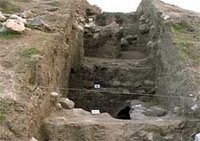A 3000-year-old Architectural Plan Discovered in Gilan

Tehran, 17 January 2006 (CHN) -- The first season of archeological excavations in Kaluraz Tepe in Gilan province led to the discovery of the first architectural plan belonging to the Iron Age (800-550 BC). There is a construction with big halls and several rooms in this historical site. Kaluraz Tepe is one of the most important historical sites in Gilan in which for the first time an architectural plan dating back to the first millennium BC was discovered. This historical site is located in Rostam Abad and recently archeologists have succeeded to find the architectural remains dates back to the Parthian era.
“During this season of excavation we succeeded in discovering architectural remains belonging to the Parthian era, and some intricate rooms. We also found out that the
 hill is surrounded by a 2-meter-wide shell keep,” said Mohammad Reza Khalatbari, director of the pre-historic unit of the Archeological Research Center and head of Kaluraz excavation team.
hill is surrounded by a 2-meter-wide shell keep,” said Mohammad Reza Khalatbari, director of the pre-historic unit of the Archeological Research Center and head of Kaluraz excavation team.“Architectural units, with halls in different sizes, are situated near the shell keep of the complex. The heater system, located at the central part of the hall, consisted of some brick bake ovens (tanoors) underneath the floor, the walls of which have been whitened by the heat of fire. Some jars have been discovered near these ovens. Archeologists believe that they might have been used in Korsies,” added Khalatbari.
Some living rooms with 38x38x10 brick floors have been found in these halls. In some other architectural areas, baking ovens and garbage cans have also been discovered.
According to Khalatbari, some dishes which have remained almost intact which belong to the second half of the first millennium BC have been discovered under the floors of the rooms. The discovered architectural areas are mostly clays while stones have been used in the construction of some parts as well. “This is the first architectural plan which has been discovered from the inhabitants of the first millennium BC in Gilan province, which is a turning point in Gilans’s archeological studies,” explained Khalatbari.
Archeological evidence and the remains of the enormous clays under the floors of the rooms indicate that this historical site was a residential area for a period of time at the end of the Parthian era. Moreover, stones were added to this construction during this period which resulted in some changes in the previous earthen architectural style of Kaluraz Hill.

0 Comments:
Post a Comment
<< Home